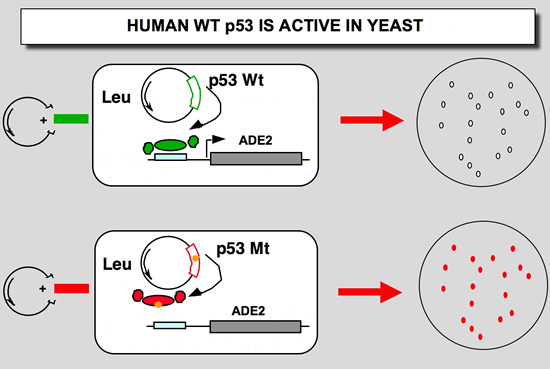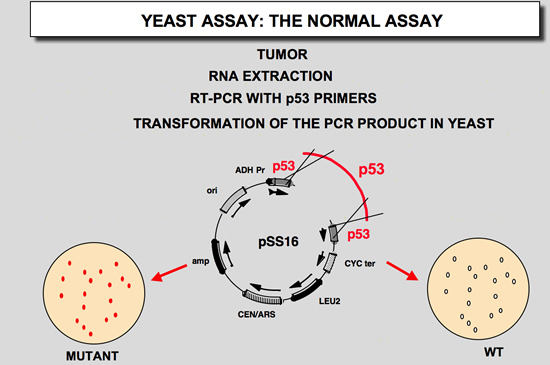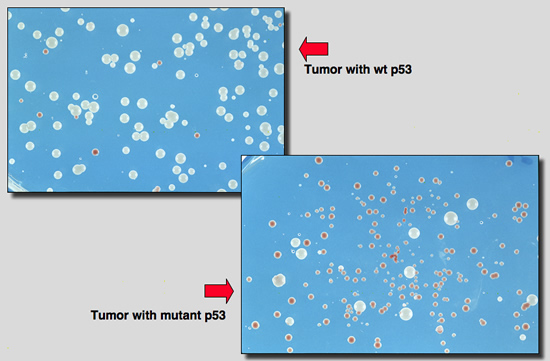| |
Our Work
The Yeast assay
p53 Chips and LDR
|
The p53 Yeast Assay (FASAY)
p53 mutations screening using the FASAY
The FASAY is very simple assay which does not require any specialised equipment or highly trained personne.
Transcriptional activation is the critical biochemical function of p53, which underlies its tumor suppressor activity. Mutant p53 proteins fail to activate transcription. Further, such transcriptional activity is functional in yeast, and p53 mutants that are inactive in humans are also inactive in yeast. The recipient yeast strain (yIG397) is defective in adenine synthesis because of a mutation in its endogenous ADE2 gene, but it contains a second copy of the ADE2 open reading frame controlled by a p53 response promoter. Because ADE2-mutant stains grown on low-adenine plates turn red, yIG397 colonies containing mutant p53 are red, whereas colonies containing wild-type p53 are white. Yeast strain yIG397 was cotransformed with PCR-amplified p53 and a linearized expression vector (pSS16), and the p53 cDNA was cloned in vivo by homologous recombination
 |
 |
| Figure 1 and 2: The FASAY; The aim of the test is as follows: using specific primers, all of the coding region of p53 RNA derived from the tumor, known to be the target of mutations, is amplified. This amplification product requires an initial RNA of perfect quality, hence the importance of the tumor sampling and freezing conditions. The amplification product is introduced into an indicator yeast. The status of the p53 gene can be verified according to the colour of the yeast. The mutant yeast (Ade-) has a deficient Adenine metabolism, which induces accumulation of a metabolite giving the yeast a red color. This strain of yeast contains a vector with the Ade gene under the control of an RGC sequence that is bound by p53. Introduction of wild type p53 into this strain of yeast restores the Ade phenotype, inducing a white color in the majority of colonies. Conversely, mutant p53 fails to bind the RGC sequence, the Ade gene remains inactive and the majority of yeast colonies appear red |
 |
| Figure 3: Typical results for FASAY. The photograph on the left was taken on a Petri dish with colonies of yeasts expressing a wild type p53, while the photograph on the right shows a mutant p53. The few red colonies observed with wild type p53 corresponds to mutations introduced by the thermostable DNA polymerase during the PCR. The white colonies (wild type p53) obtained from a tumor expressing mutant p53 correspond to either the remaining wild type allele from or from DNA extracted from normal cells that contaminates the tumor sample. |
References for FASAY
Ishioka C, Frebourg T, Yan Y, Vidal M, Friend SH, Schmidt S and Iggo R (1993) Screening patients for heterozygotous p53 mutations using a functional assay in yeast. Nature Genetics 5: 124-129.
Flaman JM, Frebourg T, Moreau V, Charbonnier F, Martin C, Chappuis P, Sappino AP, Limacher JM, Bron L, Benhattar J, Tada M, Vanmeir EG, Estreicher A and Iggo RD (1995) A simple p53 functional assay for screening cell lines, blood, and tumors. Proc Natl Acad Sci USA 92: 3963-3967.
|
|






